Meet the Berlin Art Prize 2016 Winners
Meet the Berlin Art Prize 2016 Winners
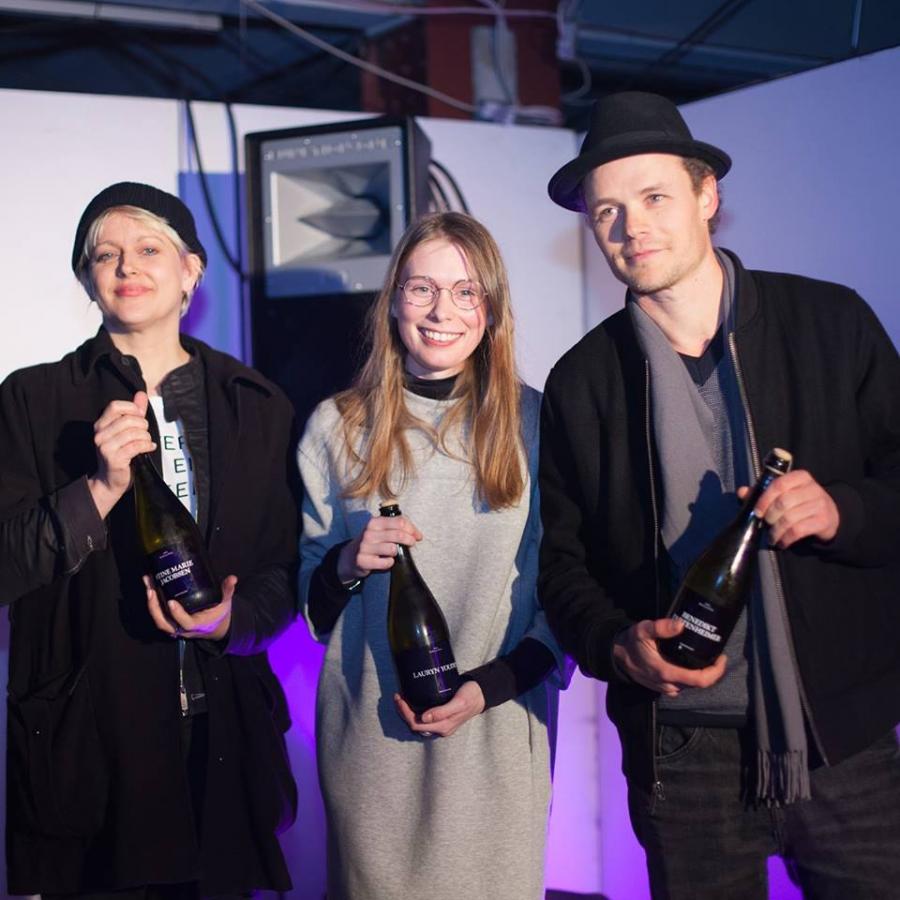
Berlin Art Prize – the independent annual award honoring contemporary art from Berlin – saw its fourth edition this year, led by the motto „Hard Work/Work Hard“. From over 600 applicants, the jury – Karen Archey, Kito Nedo, Emeka Ogboh, Ahmet Öğüt und Susanne Winterling – selected nine nominees through an anonymous procedure, and honored three winners with the trophy, prize money, and a four-week residency in Georgia. The works that stood out the most belong to Stine Marie Jacobsen, Benedikt Partenheimer and Lauryn Youden, who spoke with us about their laureated pieces, and shared some plans and hopes for the future.
For those who haven't had the chance to see the Berlin Art Prize show, introduce us to your prize-winning pieces.
Stine Marie Jacobsen: One of the projects is “Law Shifters”, where young citizens' are engaged in writing their own laws, in rejudging real court cases in unconventional judicial gameplay scenarios in order to reach to their own verdicts. We then compare and discuss their verdicts and laws with the existing and use court cases as historical documents and bodies of knowledge to initiate socratic discourses on civil liberties and changed attitudes towards racism, freedom of speech, privacy and human rights have changed. “Law Shifters”’ mission is to ignite young citizens' positioning of their own ethics, expanding their sense of relation to laws and serve as a catalyst for creating an actual influence on laws and systems of enforcement today. In Germany, I do “Law Shifters” with lawyer Bilal Alkatout and social worker Nastaran Tajeri-Foumani from Gangway. To provide alternative notions of agency within the law, we want to organise a visiting programme to law making organs in the German government. “Law Shifters” was funded by the Senate - Berliner Projektfonds Kulturelle Bildung, so we hope to close the circle.
For the Berlin Art Prize show, three court cases were rejudged. A sixth grade class from the Fichtelgebirge school in Berlin re-judged the court case of German retiree Bernd Keller, who has been sentenced to 16 years and 6 months and is now imprisoned in Greece. He and his wife were also each fined 46.000 € (!) The schoolchildren only sentencing him to 3 months of social work and have now decided they want to support and write him private letters and send him the sound recording of the court case discussion.
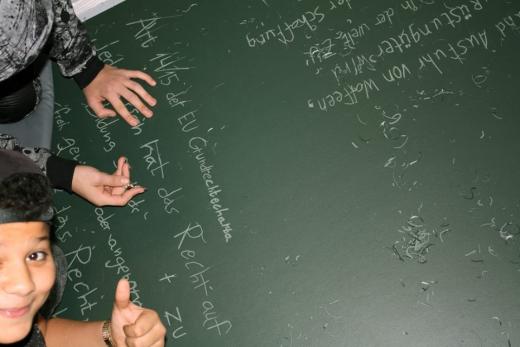
Stine Marie Jacobsen, "Law Shifters", Berlin Art Prize, 2016. © Stine Marie Jacobsen
The others are language projects called “German for Artists” and “German for Newcomers”, where syntax and grammatical power structures are explained from participants’ own actual current needs (how laws should be written) and experiences. In "German for Artists" funny mundane sentences of well-known (mostly) contemporary artists and curators visually explain a syntactical hierarchy. (I googled the top 25 name lists of artists and curators. But some sentences are based on real mundane events. Adrian Piper once did wait for me 15 min. - I still have the handwritten note and regret being late:) In “German for Newcomers”, refugees, immigrants and expats teach each other German by making their own teaching material and grammar explanations from their personal experiences. It is about not letting one’s self be“conjugated” by a state written syntax and how one’s phonetic new self “ich” is alienated, now in German making us sound like a hissing cat every time we utter ourselves in first person. German for Newcomers is supported by Aktion Mensch and a collaboration with Social Streetwork organisation Gangway e.V.

Stine Marie Jacobsen, "German for Artists", Berlin Art Prize, 2016. © Stine Marie Jacobsen
Benedikt Partenheimer: I showed three different works, which all link together thematically.
I showed three photographs from the series “Particulate Matter”. This work shows Chinese cities disappearing in air pollution and reflects upon the consequences that come along with excessive economic growth and the burning of fossil fuels. The seemingly deceptive romantic aesthetics of those images disclose their true meaning by the titles of the respective images. The titles of the images refer to the AQI (Air Quality Index), indicating the degree of air pollution.
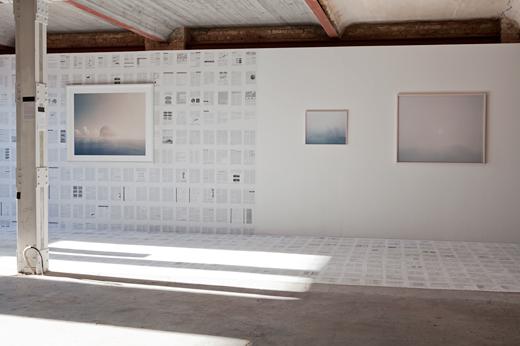
Benedikt Partenheimer, Berlin Art Prize, 2016. Photo © Benedikt Partenheimer
Additionally I showed a wall and floor installation, “Business as Usual”. A collection of 14000 A4 pages, the pages provide scientific data and facts about climate change from the early nineties until now. The idea was to cover the whole exhibition floor, so that the visitors could walk on the information and choose to ignore it. I was trying to visualize our behaviour - we all know about climate change and we are constantly surrounded by information, but most of the time we choose to ignore the facts. We do, in a way, live in the age of Post-Truth. How can we even speak of "facts" when they no longer provide us with reality that we all agree on?
The third work was a photographic montage showing the Trinity explosion. On July 16, 1945, 5:29 am 45 seconds, the United States Army conducted the first test of a nuclear weapon. The beginning of the nuclear age marks a historic turning point when humans first accessed an enormous new energy source, and also developed the ability to destroy themselves.
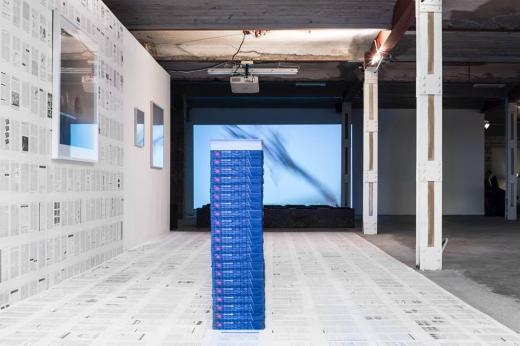
Benedikt Partenheimer, Berlin Art Prize, 2016. Photo © Anastasia Muna
Lauryn Youden: My piece which is titled “a place to retreat, when I am sick (of you) / ein ort für Erholung, wenn ich krank bin (wegen euch)”, (2016) is a large scale installation, functioning as both an immersive environment for self-healing - which consist of three himalayan rock salt gardens with medicinal herbs, aromatherapy, an audio recording of a crystal bowl sound bath - and three text-based works that are artifacts from a Cognitive-Behavioural Therapy exercise given to me by my therapist. The work also contains a physical exercise that shares parallel techniques between the production of Japanese Buddhist Zen gardens and forms of CBT to revive oneself out of a panic attack.
Throughout the duration of the exhibition I also ran my series of performances called "Sacred Serpent Sessions (SSS)". This included opening the work to the public, and inviting them to compose the elements and to design the rock salt in the installation themselves to experience the healing qualities of these techniques. Group meditation, as well as open discussions speaking about how I learned these techniques to live with my anxiety disorder, were conducted to allow for others to share their own experiences and relationships to mental illness and healing.
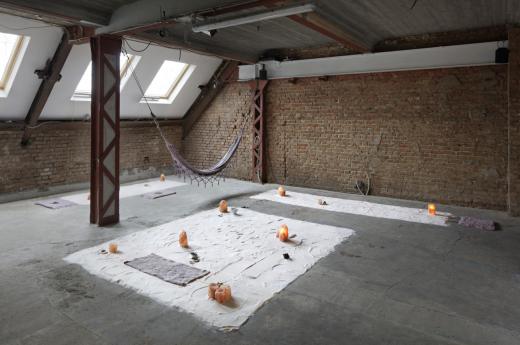
Lauryn Youdel. “a place to retreat, when I am sick (of you) / ein ort für Erholung, wenn ich krank
bin (wegen euch)”, (2016). Photo © Hans-Georg Gaul
What are the highlights of winning this prize, and how are you planning to use them?
SMJ: The highlight is all the amazing congratulations! Thank you!
BP: As an artist you spend so much time by yourself working and thinking about certain topics, so the process of having your work evaluated by an independent jury and being chosen from a multitude of portfolios is very rewarding and reassuring in itself. The highlight is knowing that my work resonates and that it might make people think.
LY: Beyond having a chance to show my work, it was important for me to create a space where mental health could become a public conversation – as it is currently largely underrepresented. If the work can open up a space to speak about these things in an art context and to be integrated, then that’s the best possible outcome. I also look forward to the residency in Georgia were I will continue my research in the history of modern medicine, especially investigating the history of abortion and contraception practices and issues in the East and West.
What is at the core of your art practice?
SMJ: I develop learning tools and create participatory educational templates in order to heighten relation to and awareness of ethics, identity, control, fear and trust and aim to raise solidarity and civic engagement through community involvement.
BP: At the moment I am particularly interested in work related to the Anthropocene, a proposed term for an epoch that begins when human activities have had significant global impact on the Earth’s ecosystems. It is with industrialization that humans began, and continue, to transform the Earth’s metabolism to a degree that now parallels geological forces. The Anthropocene is a situation that calls for re-examination, asking us to take a closer, more sensitive look at the way humans have chosen to live. How can art develop a language of critical thought that deals with aspects of a transforming space? We need fewer things that separate us and more things that connect us, and I believe that art gives us the opportunity to connect with others and ourselves; art creates an environment for people to think and feel.
LY: At the heart of my work are my personal experiences with the cultural and social taboos surrounding my own, and others, invisible disabilities and diseases. I have discovered that the most effective way for an audience to have an insight into these illnesses is by expressing my own vulnerabilities and personal experiences. It allows viewers to connect with their own healing and self-care processes by witnessing intimate details of my own.
This comes to show case my own navigations through different treatments and therapeutic practices; where each artwork becomes a tool (or made up of multiple tools and medicines), or the artefact of the therapy I have performed, for my own self-care. I am mapping my own healing process in response to bias and blind spots in Western modern medicine, and it is important to me to open an access point for foregrounding discussions on mental illness and the histories of modern medicine and alternative healing practices.
What comes next?
SMJ: Beginning of 2017, we launch a "Law Shifters" workshop booklet, which shares an engaging informational text about the history of German immigration laws. Then I go to Lebanon to collaborate with cinematographer Elsy Hajjar on my film and violence project called "Direct Approach", where people retell their most violent film scene memory and choose if they want to play victim, perpetrator or bystander. Mid January 2017, we will do more "Law Shifters" / "German for Newcomers" workshops. End of 2017, I have been invited to work at URRA Tigre, Buenos Aires, Argentine for 3 months.
BP: I am developing new works related to the term “Anthropocene” and geoengineering. In 2017 I will show works from my "Boundaries" series at Gallery "Raumsechs" in Düsseldorf. The series questions the general perception of borders and their ambivalence, and engages the viewer to explore the concepts of demarcation. Soon I will have to move out of my studio apartment in Kreuzberg, and will be looking for a new place to live and work in Berlin, so that will take up most of my time in January – any suggestions are very welcome!
LY: I am currently in discussion with a number of curators and artists who are working at a similar intersection of medicinal practices and contemporary art. I'm looking at how to best situate and develop this kind of space in our communities through exhibitions and community outreach.
Two projects I am currently working on are a publication featuring a series of texts exploring these topics, in particular in relation to the female body, mental illness and/or physical disability. The conversations around this publication and the texts already produced have been incredibly informative and productive in creating room for these important issues to be discussed and become commonplace.
Secondly, I am very excited to currently be working on the 2017 programming of Ashley Berlin, a non-profit gallery which I co-direct with curator Kate Brown. At the moment we feel an urgency to foster discussion and dialogue through readings, talks and screenings, as opposed to our regular program, which was largely exhibition-based. The hope is to cultivate an active platform for discussion and development in our artistic community. This year we will focus on four solo exhibitions with female artists, alongside an event-based program, some of which will be directly linked to my artistic practice.
In the holiday spirit: what do you wish for in 2017?
SMJ: Here goes my romanticised beauty queen contest rant: I hope people will help lower CO2 emission by eating, flying less, using less water, heating, transport and buying more LED light bulbs. That children will learn in school how to sue their governments when doing poor political work - and their parents for over-sharing pictures of them. That the EU parliament will stop negotiating the Free Trade Agreement TTIP and TAFTA behind closed doors. That EU will cancel the Dublin regulation and the EU-Turkey refugee agreement, and replace them with more humane refugee laws, which do not put the sole responsibility on southern/margin EU countries and send “irregular immigrants” back to Turkey, who anyways refuses Syrian people to cross its borders. What a Catch-22 world we live in huh?
BP: Peace, more equality, less fear and more love.
LY: 2016 has been an incredibly hard year. A lot of dramatic and challenging events have taken place, I can only wish for what everyone has experienced to instigate positive changes for the new year.
* * * * *
Lauryn Youden / laurynyouden.net
Stine Marie Jacobsen / stinemariejacobsen.com
Benedikt Partenheimer / benedikt-partenheimer.com
Read our interview with the founders (June 2015) here
Find out more about the Berlin Art Prize 2016 here